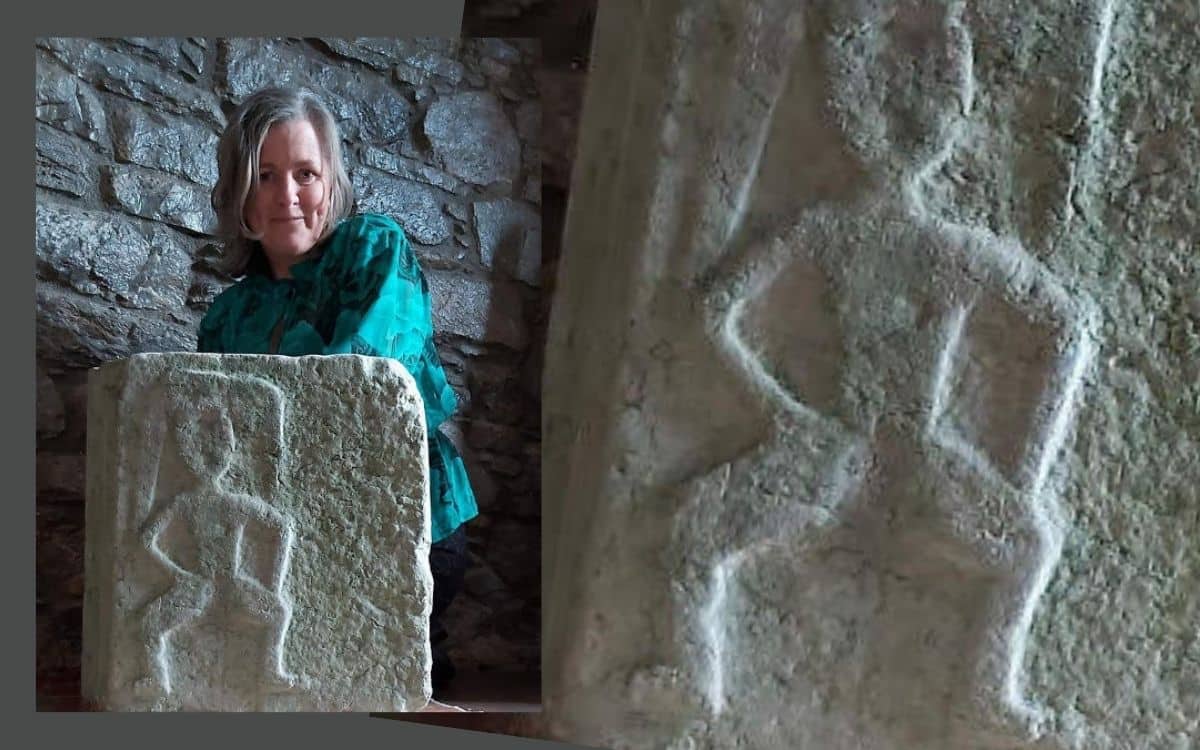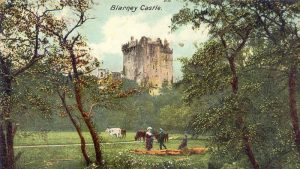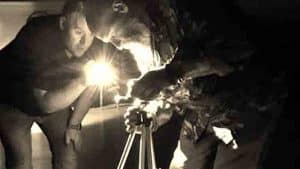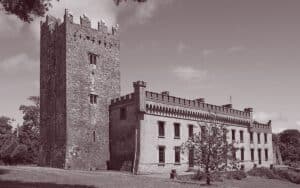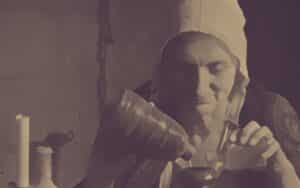For centuries mystery and folklore tales have surrounded the stone carvings known as Sheela na Gigs in Ireland. Guest writer Sheila O’Keefe owns Blackwater Castle in County Cork with her husband Patrick Nordstrom and they have one of their very own! Sheila tells us all about the significance of the phenomenon and how one came to live at her castle!
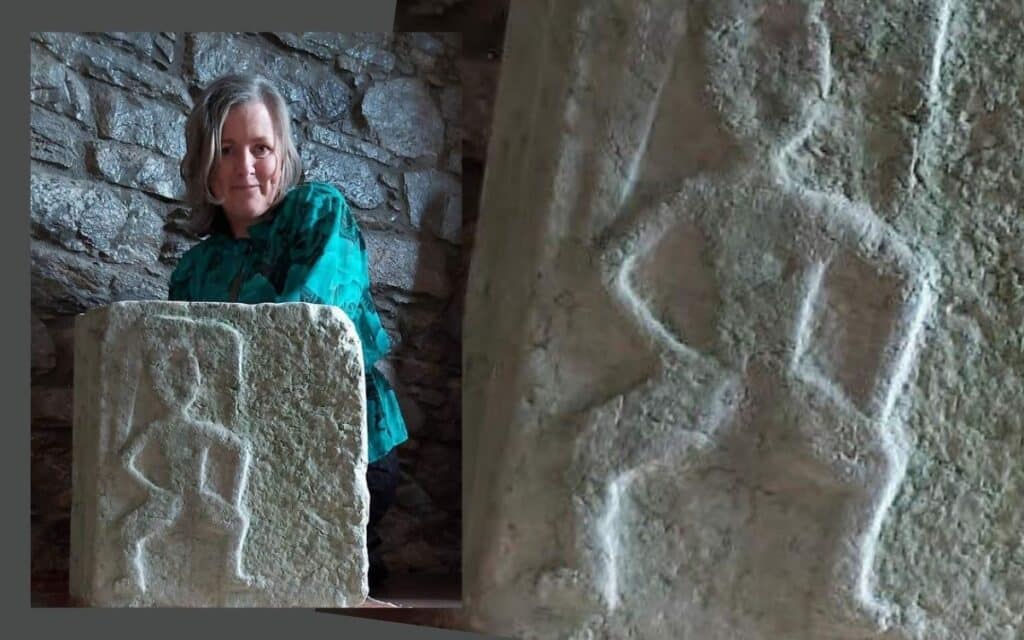
What is a Sheela na Gig?
Sheela na gigs (Síle na gcíoch in Irish) are figurative stone carvings of naked women, frequently old hag-like wizened creatures, represented in the crouched position displaying an exaggerated vulva. The figures are considered to be ugly creatures with flat or sagging breasts, visible ribs, prominent eyes, and in some cases, wearing a headdress. The carvings are generally quite crude in their execution, with few ornate touches, but there is no doubt that feminine power is centre stage.
Norman Origin
Ireland is blessed with over one hundred of them in various locations throughout the island, and many are associated with the establishment of Norman settlements from the 12th century. Their preponderance around these Norman settlements led many to suspect that the Normans introduced these symbols to Ireland but the academic consensus now is that such figures are of much earlier origin.
We are privileged to host our own Sheela here at Blackwater Castle, a late Bronze Age and Iron Age fortress which was appropriated by the Fitz-Hugh (Fitz-Gerald)/Roche family in the late 12th century following the Anglo Norman Invasion.
But while the Normans recognised the symbolic importance of these symbols and took care to incorporate them into their castles, churches, and bridges, we need to step further back in time to appreciate what these symbols of feminine power mean.
Archaeological discoveries from the Palaeolithic period have revealed symbols and figurines depicting pregnant women and “Mother Earth” type figures and further examples of such depictions abound from the Neolithic era once the cultivation of land and domestication of animals started in earnest. When our forbears became reliant on seasonality and the whims of the natural world we can see why fertility symbols took on additional importance.
More recent civilisations also sought to revere “Mother Earth” figures and here in Ireland the most renowned such Goddess would be Anu/Danu.
Irish “Mother Earth”/Fertility Figures
So what of the Sheela na Gigs of Ireland? Are they connected to female deities of fertility and life-giving powers? We must be honest and state that what we know of Sheelas derives from speculation and theorising, much of it informed by the archaeological record, later written records, traditions, and folklore so there are varying interpretations. Clearly, there is no consensus as to their origins and meaning, but there are some generally accepted possibilities.
Many view them as part of the “Mother Earth” tradition which celebrates new life springing from women, others see them as vestiges of a pre-Christian fertility cult where women and motherhood were revered. Some viewed them as apotropaic symbols (devices to ward off evil or attack or to bring about good fortune), while in later times they were viewed as warnings against lust; engage in unnecessary sexual activity and you will pay the price by becoming ugly and hag-like, quite the deterrant!
We can assume this was primarily directed at women rather than men who to this day continue to be judged by different sexual mores.
Hag Folklore
Ireland has a rich seam of folklore relating to “hags” and hag-like or witch-like figures such as the Hag of Beara and the Cailleach (or witch). Much of this folklore is bound up in the natural cycle of the seasons; the passing of winter to spring when the Winter Goddess of the Cailleach became subsumed or seasonally locked into the stone form of the Sheela thereby giving way to the Spring Goddess of Bríd.
Many of these myths and legends relate to the natural world, the changing of the seasons, the dormancy of winter, and the promise of new growth in spring.
Midwives/Childbirth Aids.
Another persuasive theory is that these symbols were carved by midwives of the time to alert women to the nature of conception and childbirth and were powerful aids to fertility. Some hold that the figures themselves represent women giving birth using the traditional squatting position.
In truth we will never know for certain the true meaning of such symbols and of course there may be grains of truth in many of these theories as to their origin and meaning. With our oral tradition of story-telling these legends and myths evolved over time as they were passed down the generations and indeed continue to captivate us as they inform our culture to this day.
The Blackwater Castle Sheela na Gig
As custodians of a Sheela na Gig here at Blackwater Castle, Castletownroche, North Cork, (formerly Castle Widenham) we are happy to share her with those who wish to appreciate her power. We have tried to piece together the history and origins of our own Sheela but the historical record, as readers will appreciate, is a little sketchy so mystery surrounds the history of this Sheela too.
Some have suggested that she at one point had been incorporated into the bridge in Castletownroche between the Corn and Woollen Mills (known as “the Old Rustic Bridge by the Mill” which was made famous by Thomas Peter Keenan, a travelling player and frequent visitor to Castletownroche who wrote a popular ballad about the bridge). It is also alleged that a local parish priest was so repulsed by the immodesty of the figure that he cast it into the river.
Certainly in Mediaeval times the Church did try to suppress such figures and traditions as they would have been viewed as contravening the “one true God” and there is much evidence of the destruction of such figures throughout the country (although some Sheelas co-existed with Christianity and there is some evidence of such figures being hidden within churches and even in one case, underneath the altar).
Our Sheela may originally have formed part of a section of a building on the site of the Castle itself as such symbols were often incorporated into defence structures and churches as a means of repelling attack and warding off evil.
We know the Castle was a fortress in the pre-Christian era and the Sheela was probably on site when the Anglo Norman Roches arrived. The Roches may simply have incorporated her into their own stronghold rather than potentially incurring the wrath of the Gods (or bad luck) by discarding her, a pattern represented in other Norman sites in Ireland. This is given added weight by the left side of the stone which shows signs of having been worked and chiselled, perhaps all the better to fit into an existing structure.
Link to Holy Well of St. Patrick
Where she was prior to the arrival of the Anglo Normans however is unclear. She could have been located in the fortress of what was then Dún Cruadha and it is also possible that she was located beside the Holy Well of St. Patrick in the river valley beneath the Castle for centuries as pagan custom frequently married such totems and charms with a Holy Well.
So during the Norman and later medieval era (12th-17th centuries) the Sheela was likely based in the fortress itself but at some point found her way back to the river valley. We know from the Ordnance Survey of 1839 that the Sheela was by then located beside the Holy Well of St. Patrick.
The natural spring (which supplies the Castle with crisp and pure Holy Well water) was likely revered in pre-Christian times for the properties of the water and may well have been a ceremonial location for pagan traditions. With the arrival of Christianity such pagan sites were co-opted by the expanding church and re-purposed to fit the Christian narrative; in the case of the Holy Well, this was dedicated to St. Patrick.
Interestingly local legend suggests that St. Patrick visited Castletownroche (located beside the Iron Age trackway of An Cliadh Dubh which links the Nagles Mountains in Cork with the Ballyhouras in Limerick and Ardpatrick, an area known to have been visited by St. Patrick). The placing of the Sheela beside the Holy Well is interesting as it may well have been part of the pagan tradition of revering such Mother Earth/fertility figures with the purity and life-giving properties of a natural spring.
So there our Sheela remained, positioned beside the Holy Well of St. Patrick from at least the mid 19th century where she would have formed part of the Pattern Day celebrating St. Patrick on 17 March, a tradition which continued in Castletownroche until the mid 20th century.
Some folklorists have suggested that Patrick was actually married to Sheela and that 18 March was known as “Sheela Day” and there is some evidence to suggest that 18 March was celebrated up to at least the 19th century. While we have re-instated the pattern day to revere Sheela on 18 March we do think it is a stretch to believe that Patrick was married to this mythical figure – his own writings seem to disprove that – however it is nice to think of Patrick and Sheela as the original early mediaeval power couple!
20th Century location
The Archaeological Survey of Ireland tells us that the Sheela was brought up from the Holy Well site in 1934 to the Courtyard of the Castle and by the mid 1980’s had been built into the wall of the dining room of the Sheela na Gig Restaurant in what was then known as the Blackwater Valley Hotel.
Anecdotally local people were both dismayed at the public display of the stone, which was deemed somewhat vulgar, and fearful that such a prominent position for the stone may bring about bad luck, harking back to one of the theories about such symbols being repellers of evil or bad luck. The placing of the Sheela in the dining room was generally viewed as inappropriate.
Local legend suggests that ill fortune befell one of the families in residence at the Castle at some undetermined point in the past and this is what led to the stone being “scourged” or cleansed of bad luck as part of a purging ritual culminating in the stone being flung into the river but we cannot establish when this may have happened if at all. (This legend may relate to the dying days of the Roche dynasty in the late 17th century when the family lost its estate and political power and Lady Roche was hanged on a trumped up charge of murder but we cannot substantiate this at present).
Our take on our Sheela
Luck or good fortune seems to be synonymous with our Sheela but there is no doubt that she is best known for the favour she may bestow on those seeking assistance with conception. Local traditions suggest that women preparing for their wedding made a pilgrimage to the Sheela and as part of the ceremony would have stroked the private parts of the Sheela in order to obtain a fertility blessing.
Nowadays, as Blackwater Castle is a wedding venue it is apt that our couples often follow that same path and also seek her blessing should they intend to have children. Sheela’s charms have attracted not just our wedding couples but others who are having difficulty conceiving also visit and ask for good fortune and her private parts, now well worn, continue to attract special attention.
And does it work you may ask? Well, while we have had many reports from those who have sought Sheela’s benediction and have subsequently attributed their babies to her interventions, we offer no guarantees here! We can say however that we are privileged to host our Sheela here at Blackwater Castle and honoured that her ancient origins as a symbol of good luck and fertility exercise, a power that endures to this day.
SHEILA O’KEEFE has written a children’s novel called The Mystery of the Sheela na Gig. For more information on this and Blackwater Castle, you can visit them at: Blackwater Castle and Sheela na Gig

